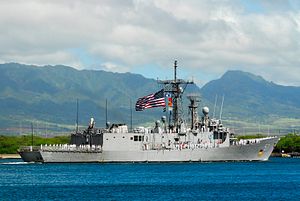It seems to be time for another round of the periodical “is the U.S. Navy big enough?” debate, which sweeps across the American defense commentator community at least once a year and usually fails to yield any significant new insights.
As I noted here, the U.S. Navy is requesting $161 billion (a $11.8 billion increase) in funds for the next fiscal year. Some of the procurement highlights outlined in the budget include three new Littoral Combat Ships, and two Virginia-class attack submarines, among other things. At the end of the decade the fleet will number greater than 300 ships, according to Secretary of the Navy Ray Mabus.
The usual modus operandi in the “is the U.S. Navy big enough” discourse is that an outsider or “non-expert” puts forward the sweeping proposition that U.S. naval forces are adequate given their likely opponents in a future conflict. Meanwhile, an insider (a retired naval officer or former Pentagon official now working for a DC-based think tank) urges readers to take heed of the Cassandra-like warnings from him and his peers about the true state of the United States Navy, religiously noting its unique contribution in upholding the current international order while simultaneously emphasizing the growing technical capabilities of naval competitors.
This time the journalist Gregg Easterbrook in a New York Times op-ed, takes the outsider perspective. Easterbrook argues that “no naval expansion is needed. The Navy has 10 nuclear-powered supercarriers — 10 more than the rest of the world. No other nation is even contemplating anything like the advanced nuclear supercarriers that the United States has under construction.” Certainly it’s a hyperbolic statement — many Asian navies are toying with the idea of nuclear-powered surface ships in the future — but still, considering the next few years, Easterbrook is more or less right with his statement .
Easterbrook further expands his argument by stating that the threats posed by other navies are grossly inflated: “Some commentators engage in fearmongering regarding China’s carriers, new submarines and its anti-ship ballistic missile. But the carriers are modest compared with America’s, the submarines far less capable than ours. And there’s no evidence that its anti-ship missile has had a realistic test.” Also partially true, yet this does not mean that the Chinese navy could not inflict a few devastating defeats on a complacent U.S. Navy.
As James Holmes notes: “Naval warfare, like military competition of all types, is a realm ruled by chaos and complexity, where opponents try constantly to frustrate and outdo one another — both in tactics and weapons design. Seldom does it lend itself to glib judgments.”
Bryan McGrath, a former naval officer, writing for War on the Rocks, offers the usual insider rebuttal noting the uniqueness of American interests, America’s unique responsibilities in the world, and the dangers of underestimating the enemy:
“Easterbrook fundamentally misunderstands what the U.S. Navy does, and why it is sized and formed as it is. He falls into the common trap of comparing our Navy against other navies, as if there were another nation on earth with our global interests and global responsibilities (…) Easterbrook’s citation of our number of carriers and comparing that to other nations fundamentally ignores the uniqueness of both our role in the world and our geography.”
The customary warning against the growing might of the Chinese Navy, China’s regional ambitions and United States treaty obligations in the world follow in the article (for other examples of this, go here and here).
What I find interesting about these naval power discussions is that they often focus too much on technical innovation at the expense of other considerations (e.g., experience, logistical capabilities etc.). Most importantly, what commentators often fail to point out is that the United States, in comparison to China and Iran, has a host of allies with very capable navies at their disposal, making any doomsday scenarios for U.S. naval forces indeed highly unlikely.

































